Learn how to compare the return on investment of maintaining your own premium wine inventory versus...
The Finicky Science of Wine Temperatures

The biggest misconception with wine is that white and red should be stored at different temperatures. Though historically, both wines were stored in underground cellars, kept at a temperature around 55 degrees Fahrenheit. While refrigeration has improved, we know that this balanced temperature is still best for storing wines.
The History of Wine’s Temperature
The process of making and fermenting wine dates back almost 8,000 years ago. While modern electric refrigeration and cooling technology barely overlaps with the history of wine, ancient civilizations always found ways to cool and sip on this refreshing beverage. Even First Century CE Rome had an ice fad, dropping lumps of snow in glasses to cool drinks.
Around this time, the original wine cooler, a psykter, was invented. This allowed wine to float in cold water or snow to stay cool during meals. When stored, wine rested in those underground cellars to maintain a low 55 degree temperature year round.
Why 55 Degrees Is Best For Wine Storage
Today, the goal with modern refrigeration and wine cooling is to mimic the historic, natural environment of these cellars, balancing both temperature and humidity when storing your wine. Many people make the mistake of keeping wines at their serving temperatures but, these extreme temps can actually cause havoc on wine long term.
The cozy neutral for any wine is 55 degrees. Storing your wines any warmer can accelerate the aging process, resulting in the wine losing its freshness and vibrancy. The opposite is true for anything colder. Aging will slow, hindering the wine's development and stunting any flavor growth.
Aiming for a cool dark cave is the best bet for storing your wine. Avoid any heat sources and windows that can cause temperature fluctuations and you should be in the clear.
Humidity Plays a Role
Beyond a wine’s temperature, humidity also plays a role in keeping wine fresh for years to come. Maintaining humidity around 60-80% is ideal, particularly for reds, where flavor enhances over time. Storing in a humidity controlled environment allows the wine to age slowly and preserve flavor.
Low humidity can shrink corks, causing oxidization and allowing microbes to enter the bottle–altering flavor and causing spoilage. The opposite, high humidity, can enable mold growth as spores work their way through the cork and into the bottle. For wine collectors looking to keep bottles pristine, excess humidity can damage wine labels with mold or excess vapor.
Plus, the perfect humidity might just make removing the cork a little easier.
Serving Temperature
The Ideal for Red
While it’s a popular belief that red wine is best at room temperature, its ideal serving temp is actually between 55 and 65 degrees Fahrenheit–think that traditional “room” temp of an underground cellar. At these slightly cooler degrees, tannins are kept fresh and flavors stay strong.
A red served too warm can overpronounce the alcoholic aromas and blind your senses to tasting the more subtle, complex flavors. Though, there’s always an opportunity to push the envelope at what temperature to serve your wine. An option is to experiment with drinking aged vintages slightly warmer, at the peak 65 degree temp, to experience the wine's full range of flavors. Or, you could go even further with a warm mulled red during the winter months.
The Ideal for White
White wine has a large serving temperature range between 43 and 57 degrees Fahrenheit. Lighter-bodied whites are best served cooler for a more refreshing sip; full-bodied whites are better at higher temperature ranges to maintain their rich flavor. These temperatures, still cooler than red, give white wine a crisp bite while maintaining its body.
Anything cooler than this can mute the wine’s aromas, muddle flavors and accentuate acidity. Serving wine too cold can also make it difficult to appreciate the wine's full range of scents and cause the body to feel too thin or watery, diminishing its richness.
But don’t worry, we won’t judge if you sip on a frosé during the summer months.
Follow us on Instagram to explore more about wine🍷




